Analyzing BEGA Cheese Limited: Financial Performance through Ratios
VerifiedAdded on 2023/06/04
|10
|2181
|235
Report
AI Summary
This report provides a comprehensive financial analysis of BEGA Cheese Limited, examining its performance from 2021 to 2022 using various financial ratios. It calculates and interprets key metrics, including current ratio, quick ratio, receivables turnover, return on equity (ROE), return on assets (...
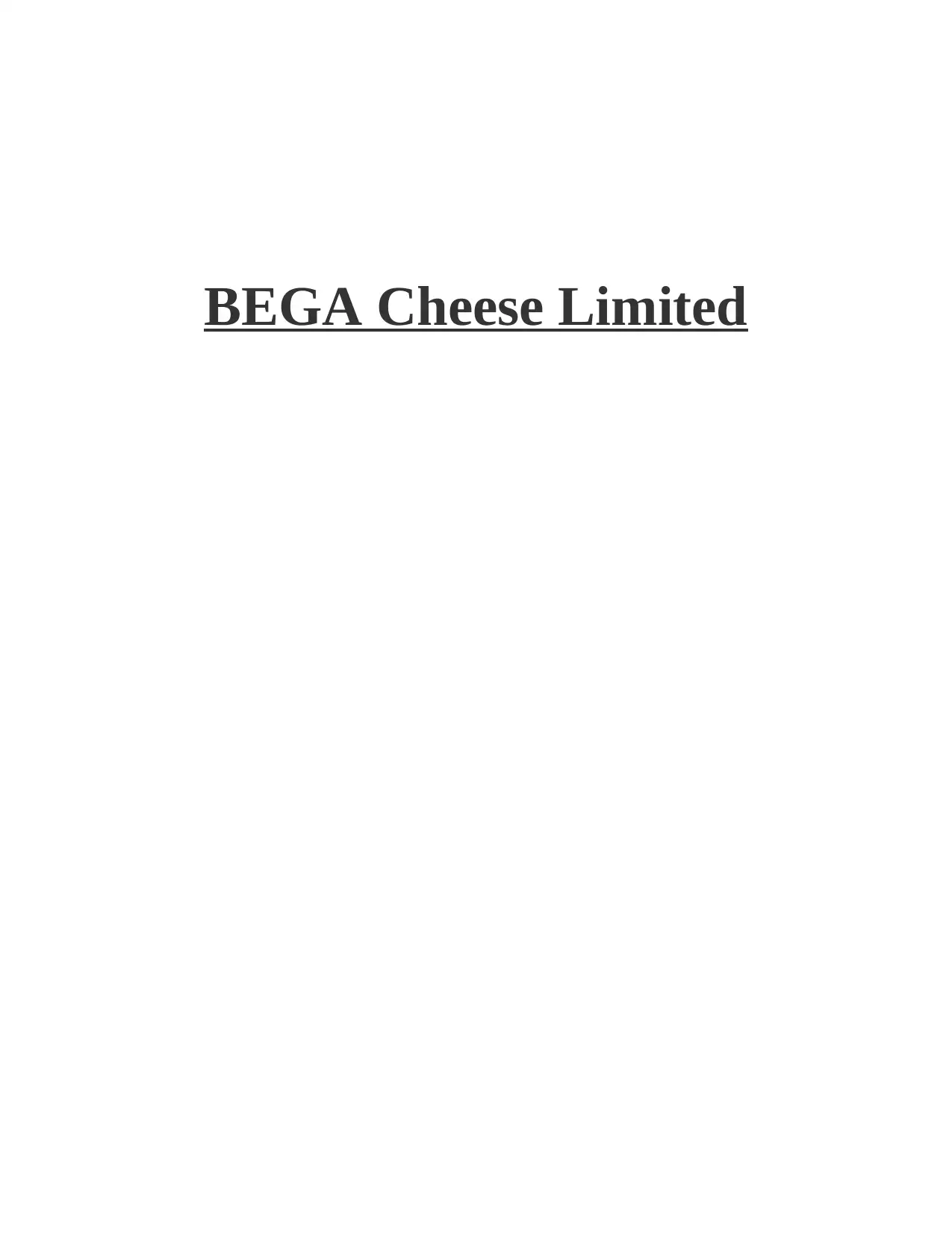
BEGA Cheese Limited
Paraphrase This Document
Need a fresh take? Get an instant paraphrase of this document with our AI Paraphraser
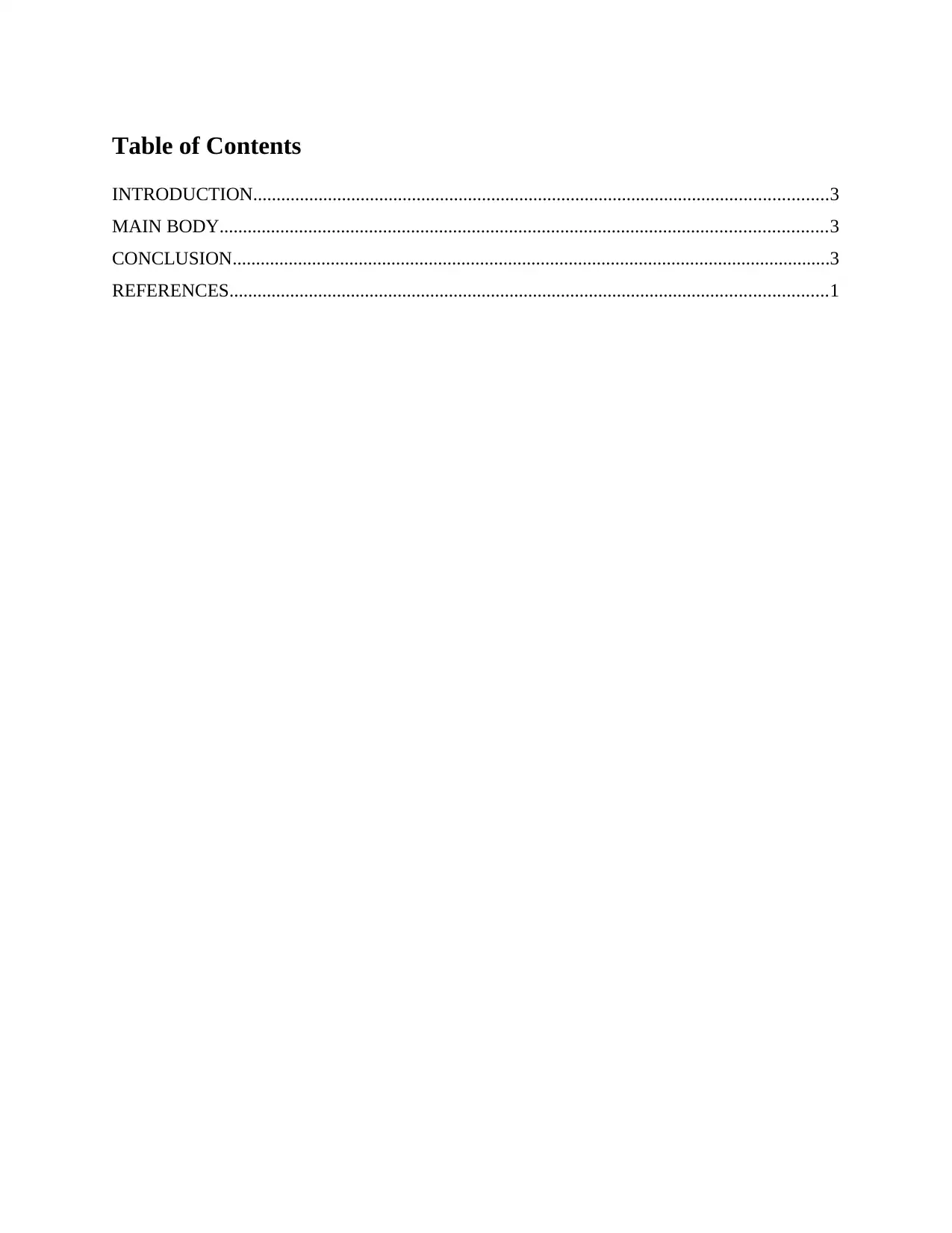
Table of Contents
INTRODUCTION...........................................................................................................................3
MAIN BODY..................................................................................................................................3
CONCLUSION................................................................................................................................3
REFERENCES................................................................................................................................1
INTRODUCTION...........................................................................................................................3
MAIN BODY..................................................................................................................................3
CONCLUSION................................................................................................................................3
REFERENCES................................................................................................................................1
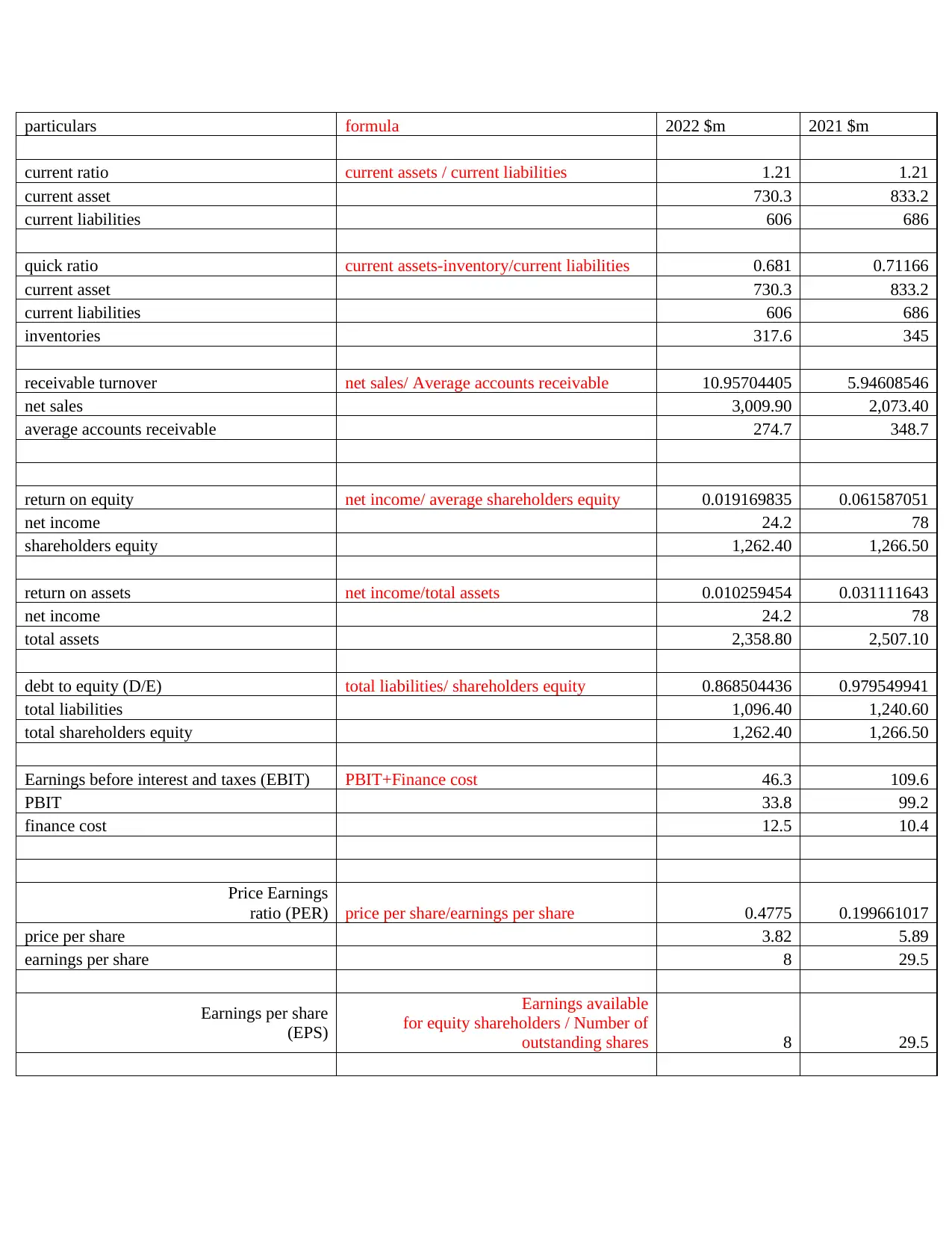
particulars formula 2022 $m 2021 $m
current ratio current assets / current liabilities 1.21 1.21
current asset 730.3 833.2
current liabilities 606 686
quick ratio current assets-inventory/current liabilities 0.681 0.71166
current asset 730.3 833.2
current liabilities 606 686
inventories 317.6 345
receivable turnover net sales/ Average accounts receivable 10.95704405 5.94608546
net sales 3,009.90 2,073.40
average accounts receivable 274.7 348.7
return on equity net income/ average shareholders equity 0.019169835 0.061587051
net income 24.2 78
shareholders equity 1,262.40 1,266.50
return on assets net income/total assets 0.010259454 0.031111643
net income 24.2 78
total assets 2,358.80 2,507.10
debt to equity (D/E) total liabilities/ shareholders equity 0.868504436 0.979549941
total liabilities 1,096.40 1,240.60
total shareholders equity 1,262.40 1,266.50
Earnings before interest and taxes (EBIT) PBIT+Finance cost 46.3 109.6
PBIT 33.8 99.2
finance cost 12.5 10.4
Price Earnings
ratio (PER) price per share/earnings per share 0.4775 0.199661017
price per share 3.82 5.89
earnings per share 8 29.5
Earnings per share
(EPS)
Earnings available
for equity shareholders / Number of
outstanding shares 8 29.5
current ratio current assets / current liabilities 1.21 1.21
current asset 730.3 833.2
current liabilities 606 686
quick ratio current assets-inventory/current liabilities 0.681 0.71166
current asset 730.3 833.2
current liabilities 606 686
inventories 317.6 345
receivable turnover net sales/ Average accounts receivable 10.95704405 5.94608546
net sales 3,009.90 2,073.40
average accounts receivable 274.7 348.7
return on equity net income/ average shareholders equity 0.019169835 0.061587051
net income 24.2 78
shareholders equity 1,262.40 1,266.50
return on assets net income/total assets 0.010259454 0.031111643
net income 24.2 78
total assets 2,358.80 2,507.10
debt to equity (D/E) total liabilities/ shareholders equity 0.868504436 0.979549941
total liabilities 1,096.40 1,240.60
total shareholders equity 1,262.40 1,266.50
Earnings before interest and taxes (EBIT) PBIT+Finance cost 46.3 109.6
PBIT 33.8 99.2
finance cost 12.5 10.4
Price Earnings
ratio (PER) price per share/earnings per share 0.4775 0.199661017
price per share 3.82 5.89
earnings per share 8 29.5
Earnings per share
(EPS)
Earnings available
for equity shareholders / Number of
outstanding shares 8 29.5
⊘ This is a preview!⊘
Do you want full access?
Subscribe today to unlock all pages.

Trusted by 1+ million students worldwide
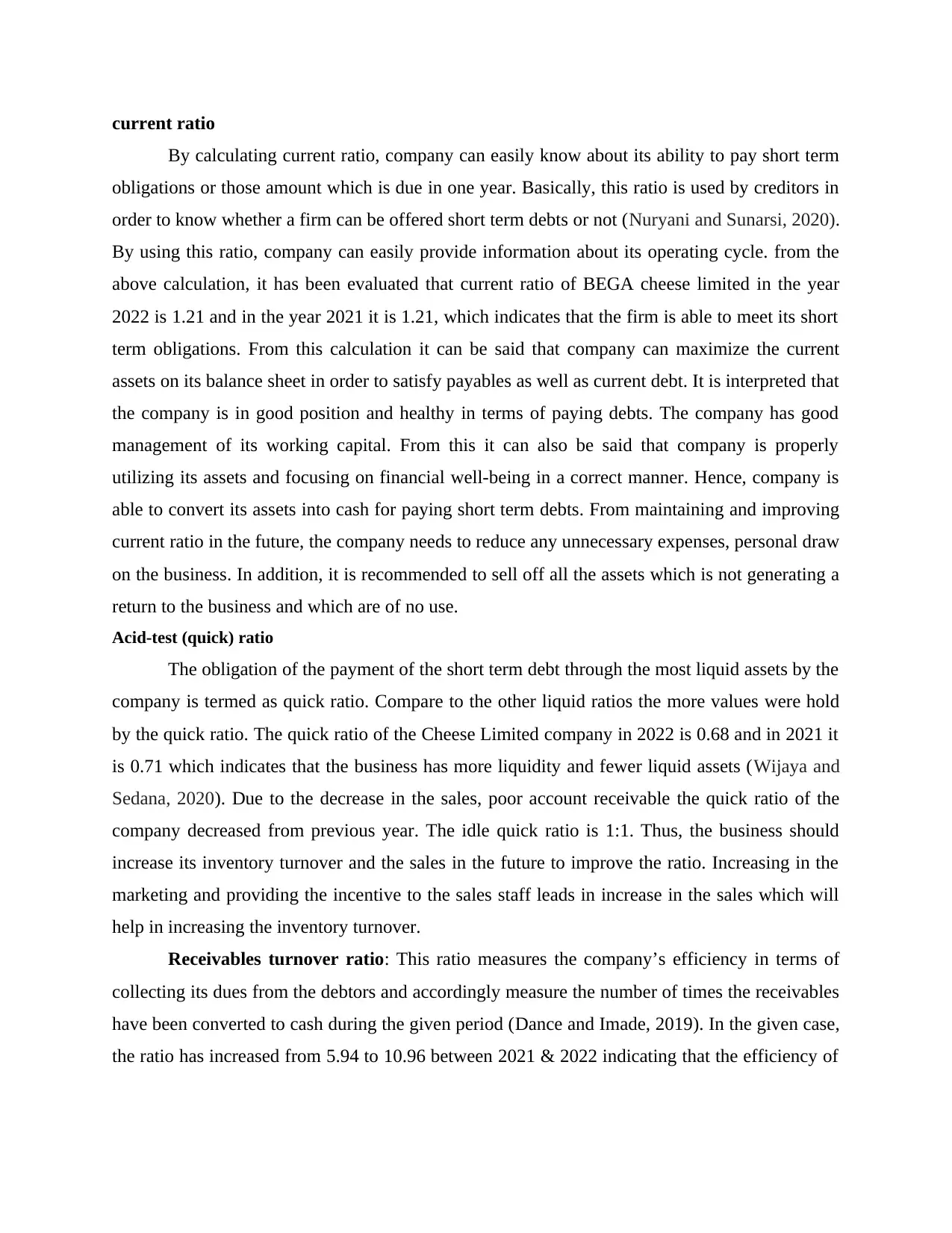
current ratio
By calculating current ratio, company can easily know about its ability to pay short term
obligations or those amount which is due in one year. Basically, this ratio is used by creditors in
order to know whether a firm can be offered short term debts or not (Nuryani and Sunarsi, 2020).
By using this ratio, company can easily provide information about its operating cycle. from the
above calculation, it has been evaluated that current ratio of BEGA cheese limited in the year
2022 is 1.21 and in the year 2021 it is 1.21, which indicates that the firm is able to meet its short
term obligations. From this calculation it can be said that company can maximize the current
assets on its balance sheet in order to satisfy payables as well as current debt. It is interpreted that
the company is in good position and healthy in terms of paying debts. The company has good
management of its working capital. From this it can also be said that company is properly
utilizing its assets and focusing on financial well-being in a correct manner. Hence, company is
able to convert its assets into cash for paying short term debts. From maintaining and improving
current ratio in the future, the company needs to reduce any unnecessary expenses, personal draw
on the business. In addition, it is recommended to sell off all the assets which is not generating a
return to the business and which are of no use.
Acid-test (quick) ratio
The obligation of the payment of the short term debt through the most liquid assets by the
company is termed as quick ratio. Compare to the other liquid ratios the more values were hold
by the quick ratio. The quick ratio of the Cheese Limited company in 2022 is 0.68 and in 2021 it
is 0.71 which indicates that the business has more liquidity and fewer liquid assets (Wijaya and
Sedana, 2020). Due to the decrease in the sales, poor account receivable the quick ratio of the
company decreased from previous year. The idle quick ratio is 1:1. Thus, the business should
increase its inventory turnover and the sales in the future to improve the ratio. Increasing in the
marketing and providing the incentive to the sales staff leads in increase in the sales which will
help in increasing the inventory turnover.
Receivables turnover ratio: This ratio measures the company’s efficiency in terms of
collecting its dues from the debtors and accordingly measure the number of times the receivables
have been converted to cash during the given period (Dance and Imade, 2019). In the given case,
the ratio has increased from 5.94 to 10.96 between 2021 & 2022 indicating that the efficiency of
By calculating current ratio, company can easily know about its ability to pay short term
obligations or those amount which is due in one year. Basically, this ratio is used by creditors in
order to know whether a firm can be offered short term debts or not (Nuryani and Sunarsi, 2020).
By using this ratio, company can easily provide information about its operating cycle. from the
above calculation, it has been evaluated that current ratio of BEGA cheese limited in the year
2022 is 1.21 and in the year 2021 it is 1.21, which indicates that the firm is able to meet its short
term obligations. From this calculation it can be said that company can maximize the current
assets on its balance sheet in order to satisfy payables as well as current debt. It is interpreted that
the company is in good position and healthy in terms of paying debts. The company has good
management of its working capital. From this it can also be said that company is properly
utilizing its assets and focusing on financial well-being in a correct manner. Hence, company is
able to convert its assets into cash for paying short term debts. From maintaining and improving
current ratio in the future, the company needs to reduce any unnecessary expenses, personal draw
on the business. In addition, it is recommended to sell off all the assets which is not generating a
return to the business and which are of no use.
Acid-test (quick) ratio
The obligation of the payment of the short term debt through the most liquid assets by the
company is termed as quick ratio. Compare to the other liquid ratios the more values were hold
by the quick ratio. The quick ratio of the Cheese Limited company in 2022 is 0.68 and in 2021 it
is 0.71 which indicates that the business has more liquidity and fewer liquid assets (Wijaya and
Sedana, 2020). Due to the decrease in the sales, poor account receivable the quick ratio of the
company decreased from previous year. The idle quick ratio is 1:1. Thus, the business should
increase its inventory turnover and the sales in the future to improve the ratio. Increasing in the
marketing and providing the incentive to the sales staff leads in increase in the sales which will
help in increasing the inventory turnover.
Receivables turnover ratio: This ratio measures the company’s efficiency in terms of
collecting its dues from the debtors and accordingly measure the number of times the receivables
have been converted to cash during the given period (Dance and Imade, 2019). In the given case,
the ratio has increased from 5.94 to 10.96 between 2021 & 2022 indicating that the efficiency of
Paraphrase This Document
Need a fresh take? Get an instant paraphrase of this document with our AI Paraphraser
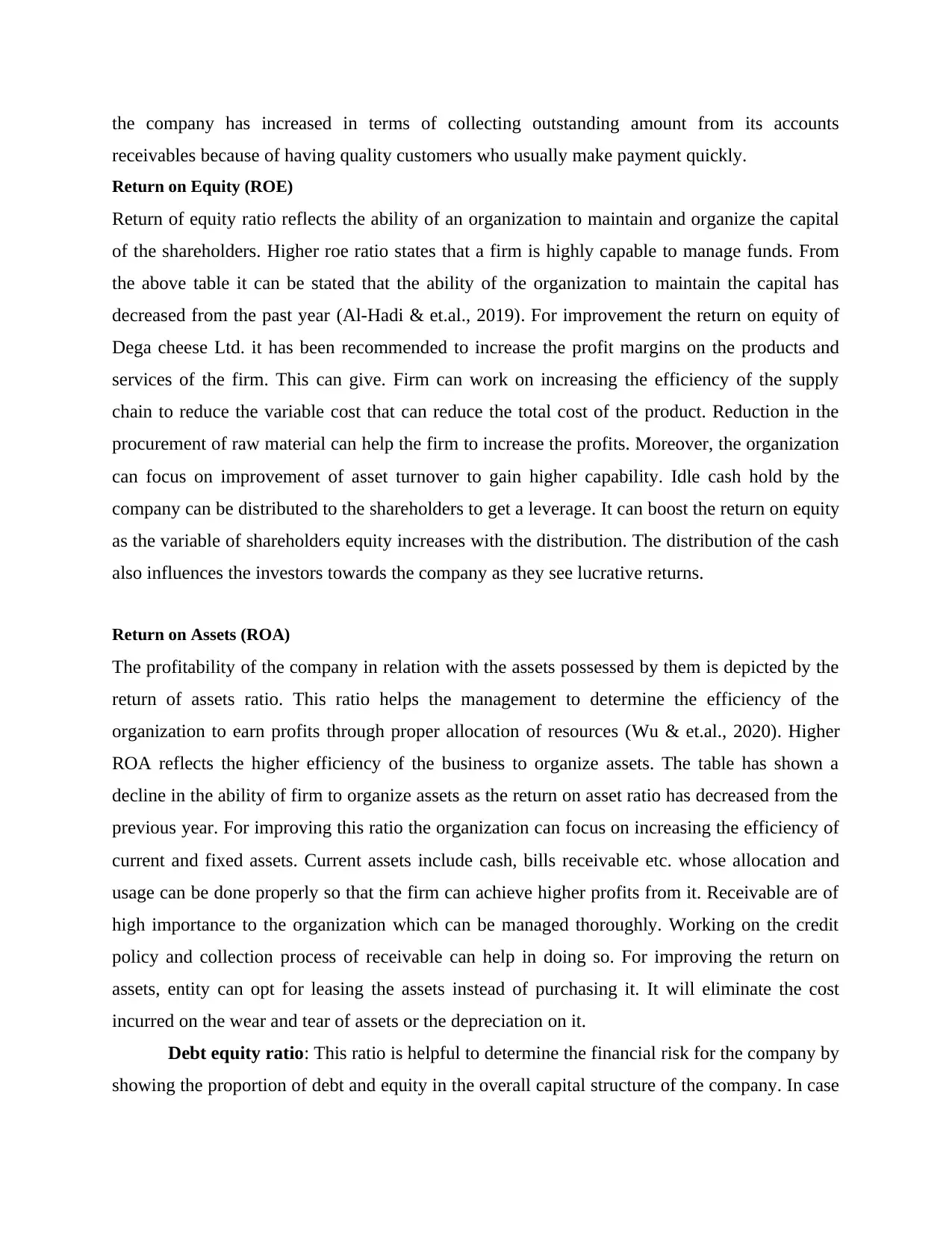
the company has increased in terms of collecting outstanding amount from its accounts
receivables because of having quality customers who usually make payment quickly.
Return on Equity (ROE)
Return of equity ratio reflects the ability of an organization to maintain and organize the capital
of the shareholders. Higher roe ratio states that a firm is highly capable to manage funds. From
the above table it can be stated that the ability of the organization to maintain the capital has
decreased from the past year (Al‐Hadi & et.al., 2019). For improvement the return on equity of
Dega cheese Ltd. it has been recommended to increase the profit margins on the products and
services of the firm. This can give. Firm can work on increasing the efficiency of the supply
chain to reduce the variable cost that can reduce the total cost of the product. Reduction in the
procurement of raw material can help the firm to increase the profits. Moreover, the organization
can focus on improvement of asset turnover to gain higher capability. Idle cash hold by the
company can be distributed to the shareholders to get a leverage. It can boost the return on equity
as the variable of shareholders equity increases with the distribution. The distribution of the cash
also influences the investors towards the company as they see lucrative returns.
Return on Assets (ROA)
The profitability of the company in relation with the assets possessed by them is depicted by the
return of assets ratio. This ratio helps the management to determine the efficiency of the
organization to earn profits through proper allocation of resources (Wu & et.al., 2020). Higher
ROA reflects the higher efficiency of the business to organize assets. The table has shown a
decline in the ability of firm to organize assets as the return on asset ratio has decreased from the
previous year. For improving this ratio the organization can focus on increasing the efficiency of
current and fixed assets. Current assets include cash, bills receivable etc. whose allocation and
usage can be done properly so that the firm can achieve higher profits from it. Receivable are of
high importance to the organization which can be managed thoroughly. Working on the credit
policy and collection process of receivable can help in doing so. For improving the return on
assets, entity can opt for leasing the assets instead of purchasing it. It will eliminate the cost
incurred on the wear and tear of assets or the depreciation on it.
Debt equity ratio: This ratio is helpful to determine the financial risk for the company by
showing the proportion of debt and equity in the overall capital structure of the company. In case
receivables because of having quality customers who usually make payment quickly.
Return on Equity (ROE)
Return of equity ratio reflects the ability of an organization to maintain and organize the capital
of the shareholders. Higher roe ratio states that a firm is highly capable to manage funds. From
the above table it can be stated that the ability of the organization to maintain the capital has
decreased from the past year (Al‐Hadi & et.al., 2019). For improvement the return on equity of
Dega cheese Ltd. it has been recommended to increase the profit margins on the products and
services of the firm. This can give. Firm can work on increasing the efficiency of the supply
chain to reduce the variable cost that can reduce the total cost of the product. Reduction in the
procurement of raw material can help the firm to increase the profits. Moreover, the organization
can focus on improvement of asset turnover to gain higher capability. Idle cash hold by the
company can be distributed to the shareholders to get a leverage. It can boost the return on equity
as the variable of shareholders equity increases with the distribution. The distribution of the cash
also influences the investors towards the company as they see lucrative returns.
Return on Assets (ROA)
The profitability of the company in relation with the assets possessed by them is depicted by the
return of assets ratio. This ratio helps the management to determine the efficiency of the
organization to earn profits through proper allocation of resources (Wu & et.al., 2020). Higher
ROA reflects the higher efficiency of the business to organize assets. The table has shown a
decline in the ability of firm to organize assets as the return on asset ratio has decreased from the
previous year. For improving this ratio the organization can focus on increasing the efficiency of
current and fixed assets. Current assets include cash, bills receivable etc. whose allocation and
usage can be done properly so that the firm can achieve higher profits from it. Receivable are of
high importance to the organization which can be managed thoroughly. Working on the credit
policy and collection process of receivable can help in doing so. For improving the return on
assets, entity can opt for leasing the assets instead of purchasing it. It will eliminate the cost
incurred on the wear and tear of assets or the depreciation on it.
Debt equity ratio: This ratio is helpful to determine the financial risk for the company by
showing the proportion of debt and equity in the overall capital structure of the company. In case
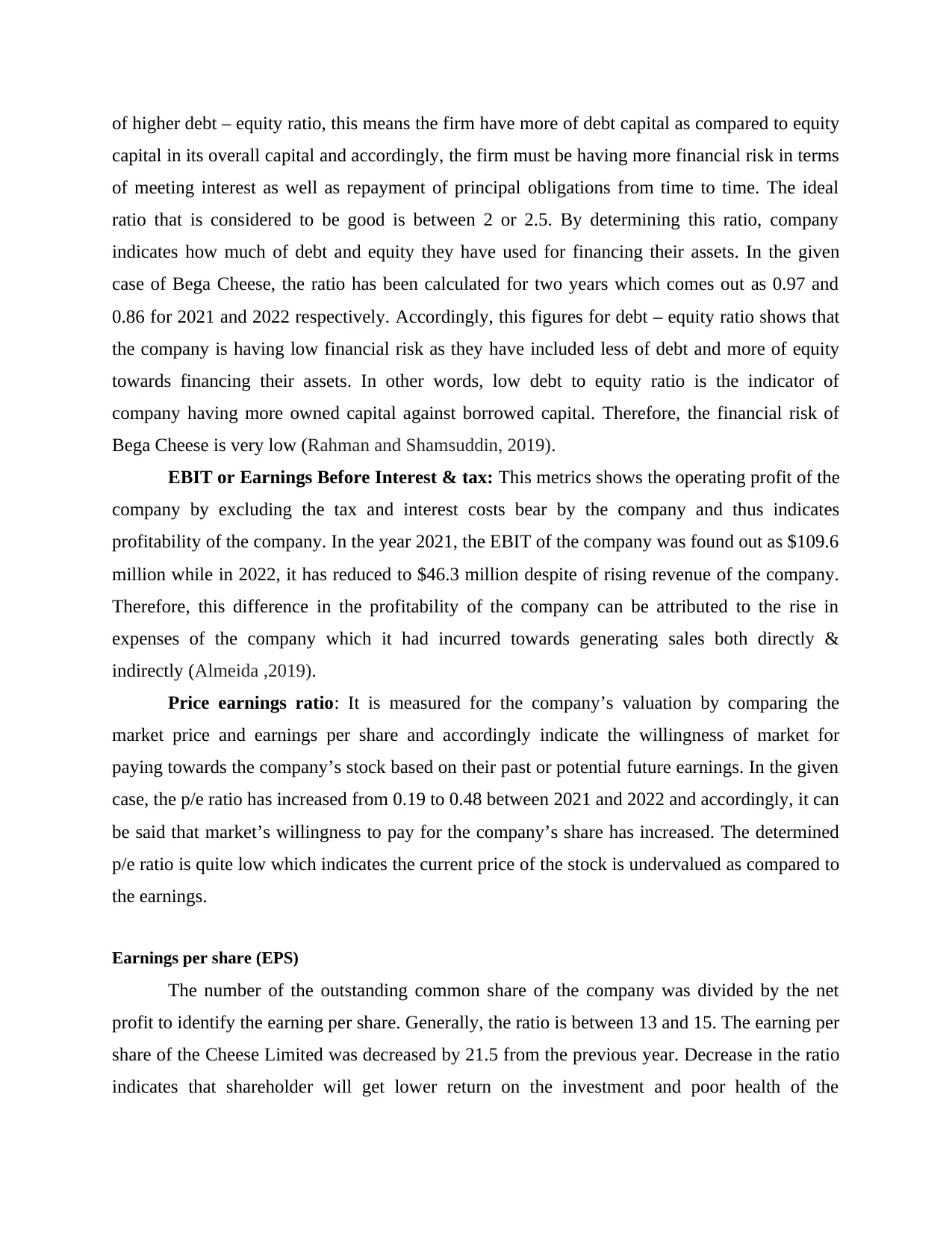
of higher debt – equity ratio, this means the firm have more of debt capital as compared to equity
capital in its overall capital and accordingly, the firm must be having more financial risk in terms
of meeting interest as well as repayment of principal obligations from time to time. The ideal
ratio that is considered to be good is between 2 or 2.5. By determining this ratio, company
indicates how much of debt and equity they have used for financing their assets. In the given
case of Bega Cheese, the ratio has been calculated for two years which comes out as 0.97 and
0.86 for 2021 and 2022 respectively. Accordingly, this figures for debt – equity ratio shows that
the company is having low financial risk as they have included less of debt and more of equity
towards financing their assets. In other words, low debt to equity ratio is the indicator of
company having more owned capital against borrowed capital. Therefore, the financial risk of
Bega Cheese is very low (Rahman and Shamsuddin, 2019).
EBIT or Earnings Before Interest & tax: This metrics shows the operating profit of the
company by excluding the tax and interest costs bear by the company and thus indicates
profitability of the company. In the year 2021, the EBIT of the company was found out as $109.6
million while in 2022, it has reduced to $46.3 million despite of rising revenue of the company.
Therefore, this difference in the profitability of the company can be attributed to the rise in
expenses of the company which it had incurred towards generating sales both directly &
indirectly (Almeida ,2019).
Price earnings ratio: It is measured for the company’s valuation by comparing the
market price and earnings per share and accordingly indicate the willingness of market for
paying towards the company’s stock based on their past or potential future earnings. In the given
case, the p/e ratio has increased from 0.19 to 0.48 between 2021 and 2022 and accordingly, it can
be said that market’s willingness to pay for the company’s share has increased. The determined
p/e ratio is quite low which indicates the current price of the stock is undervalued as compared to
the earnings.
Earnings per share (EPS)
The number of the outstanding common share of the company was divided by the net
profit to identify the earning per share. Generally, the ratio is between 13 and 15. The earning per
share of the Cheese Limited was decreased by 21.5 from the previous year. Decrease in the ratio
indicates that shareholder will get lower return on the investment and poor health of the
capital in its overall capital and accordingly, the firm must be having more financial risk in terms
of meeting interest as well as repayment of principal obligations from time to time. The ideal
ratio that is considered to be good is between 2 or 2.5. By determining this ratio, company
indicates how much of debt and equity they have used for financing their assets. In the given
case of Bega Cheese, the ratio has been calculated for two years which comes out as 0.97 and
0.86 for 2021 and 2022 respectively. Accordingly, this figures for debt – equity ratio shows that
the company is having low financial risk as they have included less of debt and more of equity
towards financing their assets. In other words, low debt to equity ratio is the indicator of
company having more owned capital against borrowed capital. Therefore, the financial risk of
Bega Cheese is very low (Rahman and Shamsuddin, 2019).
EBIT or Earnings Before Interest & tax: This metrics shows the operating profit of the
company by excluding the tax and interest costs bear by the company and thus indicates
profitability of the company. In the year 2021, the EBIT of the company was found out as $109.6
million while in 2022, it has reduced to $46.3 million despite of rising revenue of the company.
Therefore, this difference in the profitability of the company can be attributed to the rise in
expenses of the company which it had incurred towards generating sales both directly &
indirectly (Almeida ,2019).
Price earnings ratio: It is measured for the company’s valuation by comparing the
market price and earnings per share and accordingly indicate the willingness of market for
paying towards the company’s stock based on their past or potential future earnings. In the given
case, the p/e ratio has increased from 0.19 to 0.48 between 2021 and 2022 and accordingly, it can
be said that market’s willingness to pay for the company’s share has increased. The determined
p/e ratio is quite low which indicates the current price of the stock is undervalued as compared to
the earnings.
Earnings per share (EPS)
The number of the outstanding common share of the company was divided by the net
profit to identify the earning per share. Generally, the ratio is between 13 and 15. The earning per
share of the Cheese Limited was decreased by 21.5 from the previous year. Decrease in the ratio
indicates that shareholder will get lower return on the investment and poor health of the
⊘ This is a preview!⊘
Do you want full access?
Subscribe today to unlock all pages.

Trusted by 1+ million students worldwide
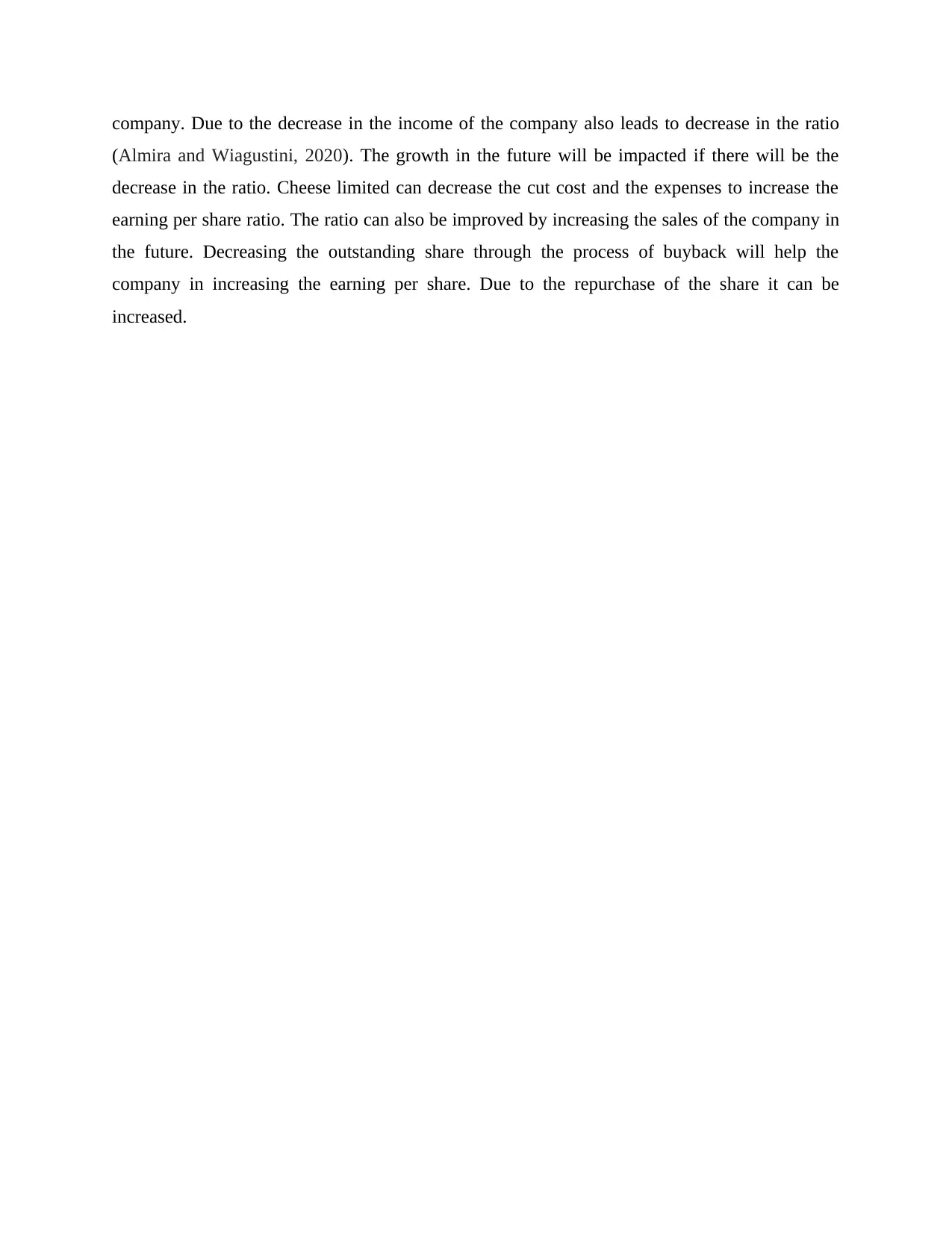
company. Due to the decrease in the income of the company also leads to decrease in the ratio
(Almira and Wiagustini, 2020). The growth in the future will be impacted if there will be the
decrease in the ratio. Cheese limited can decrease the cut cost and the expenses to increase the
earning per share ratio. The ratio can also be improved by increasing the sales of the company in
the future. Decreasing the outstanding share through the process of buyback will help the
company in increasing the earning per share. Due to the repurchase of the share it can be
increased.
(Almira and Wiagustini, 2020). The growth in the future will be impacted if there will be the
decrease in the ratio. Cheese limited can decrease the cut cost and the expenses to increase the
earning per share ratio. The ratio can also be improved by increasing the sales of the company in
the future. Decreasing the outstanding share through the process of buyback will help the
company in increasing the earning per share. Due to the repurchase of the share it can be
increased.
Paraphrase This Document
Need a fresh take? Get an instant paraphrase of this document with our AI Paraphraser

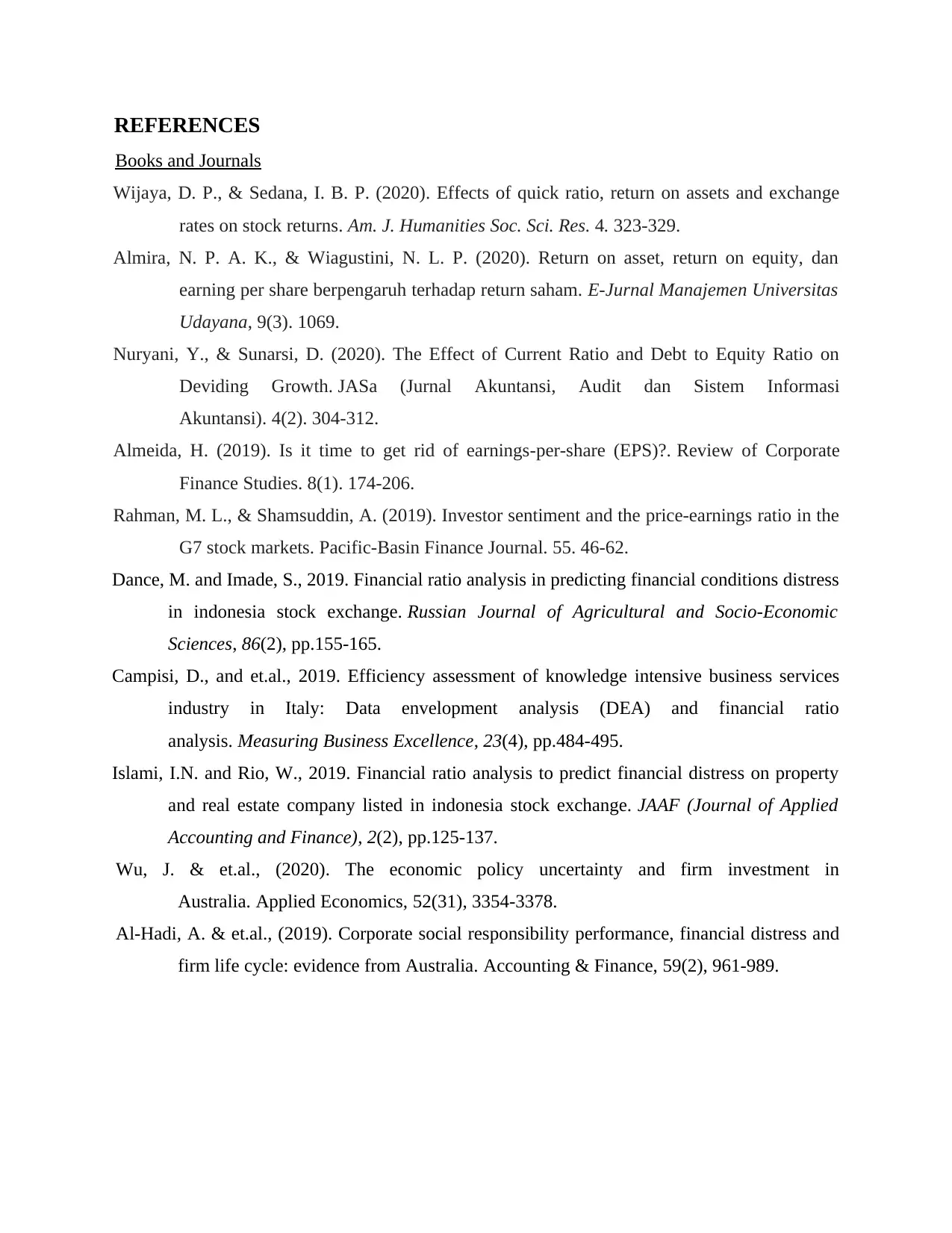
REFERENCES
Books and Journals
Wijaya, D. P., & Sedana, I. B. P. (2020). Effects of quick ratio, return on assets and exchange
rates on stock returns. Am. J. Humanities Soc. Sci. Res. 4. 323-329.
Almira, N. P. A. K., & Wiagustini, N. L. P. (2020). Return on asset, return on equity, dan
earning per share berpengaruh terhadap return saham. E-Jurnal Manajemen Universitas
Udayana, 9(3). 1069.
Nuryani, Y., & Sunarsi, D. (2020). The Effect of Current Ratio and Debt to Equity Ratio on
Deviding Growth. JASa (Jurnal Akuntansi, Audit dan Sistem Informasi
Akuntansi). 4(2). 304-312.
Almeida, H. (2019). Is it time to get rid of earnings-per-share (EPS)?. Review of Corporate
Finance Studies. 8(1). 174-206.
Rahman, M. L., & Shamsuddin, A. (2019). Investor sentiment and the price-earnings ratio in the
G7 stock markets. Pacific-Basin Finance Journal. 55. 46-62.
Dance, M. and Imade, S., 2019. Financial ratio analysis in predicting financial conditions distress
in indonesia stock exchange. Russian Journal of Agricultural and Socio-Economic
Sciences, 86(2), pp.155-165.
Campisi, D., and et.al., 2019. Efficiency assessment of knowledge intensive business services
industry in Italy: Data envelopment analysis (DEA) and financial ratio
analysis. Measuring Business Excellence, 23(4), pp.484-495.
Islami, I.N. and Rio, W., 2019. Financial ratio analysis to predict financial distress on property
and real estate company listed in indonesia stock exchange. JAAF (Journal of Applied
Accounting and Finance), 2(2), pp.125-137.
Wu, J. & et.al., (2020). The economic policy uncertainty and firm investment in
Australia. Applied Economics, 52(31), 3354-3378.
Al‐Hadi, A. & et.al., (2019). Corporate social responsibility performance, financial distress and
firm life cycle: evidence from Australia. Accounting & Finance, 59(2), 961-989.
Books and Journals
Wijaya, D. P., & Sedana, I. B. P. (2020). Effects of quick ratio, return on assets and exchange
rates on stock returns. Am. J. Humanities Soc. Sci. Res. 4. 323-329.
Almira, N. P. A. K., & Wiagustini, N. L. P. (2020). Return on asset, return on equity, dan
earning per share berpengaruh terhadap return saham. E-Jurnal Manajemen Universitas
Udayana, 9(3). 1069.
Nuryani, Y., & Sunarsi, D. (2020). The Effect of Current Ratio and Debt to Equity Ratio on
Deviding Growth. JASa (Jurnal Akuntansi, Audit dan Sistem Informasi
Akuntansi). 4(2). 304-312.
Almeida, H. (2019). Is it time to get rid of earnings-per-share (EPS)?. Review of Corporate
Finance Studies. 8(1). 174-206.
Rahman, M. L., & Shamsuddin, A. (2019). Investor sentiment and the price-earnings ratio in the
G7 stock markets. Pacific-Basin Finance Journal. 55. 46-62.
Dance, M. and Imade, S., 2019. Financial ratio analysis in predicting financial conditions distress
in indonesia stock exchange. Russian Journal of Agricultural and Socio-Economic
Sciences, 86(2), pp.155-165.
Campisi, D., and et.al., 2019. Efficiency assessment of knowledge intensive business services
industry in Italy: Data envelopment analysis (DEA) and financial ratio
analysis. Measuring Business Excellence, 23(4), pp.484-495.
Islami, I.N. and Rio, W., 2019. Financial ratio analysis to predict financial distress on property
and real estate company listed in indonesia stock exchange. JAAF (Journal of Applied
Accounting and Finance), 2(2), pp.125-137.
Wu, J. & et.al., (2020). The economic policy uncertainty and firm investment in
Australia. Applied Economics, 52(31), 3354-3378.
Al‐Hadi, A. & et.al., (2019). Corporate social responsibility performance, financial distress and
firm life cycle: evidence from Australia. Accounting & Finance, 59(2), 961-989.
⊘ This is a preview!⊘
Do you want full access?
Subscribe today to unlock all pages.

Trusted by 1+ million students worldwide

1 out of 10
Related Documents
Your All-in-One AI-Powered Toolkit for Academic Success.
+13062052269
info@desklib.com
Available 24*7 on WhatsApp / Email
![[object Object]](/_next/static/media/star-bottom.7253800d.svg)
Unlock your academic potential
© 2024 | Zucol Services PVT LTD | All rights reserved.





